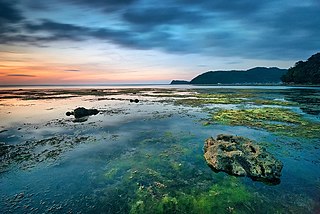
A mangrove is a shrub or small tree that grows in coastal saline or brackish water. The term is also used for tropical coastal vegetation consisting of such species. Mangroves occur worldwide in the tropics and subtropics, mainly between latitudes 30° N and 30° S, with the greatest mangrove area within 5° of the equator The total mangrove forest area of the world in 2000 was 137,800 km2 (53,200 sq mi), spanning 118 countries and territories.

Aklan, officially the Province of Aklan, is a province in the Western Visayas region of the Philippines. Its capital is Kalibo. The province is situated in the northwest portion of Panay Island, bordering Antique to the southwest, and Capiz to the east. Aklan faces the Sibuyan Sea and Romblon province to the north.

Kalibo, officially the Municipality of Kalibo, is a 1st class municipality and capital of the Province of Aklan, Philippines. According to the 2015 census, it has a population of 80,605 people.

Batan, officially the Municipality of Batan, is a 4th class municipality in the province of Aklan, Philippines. According to the 2015 census, it has a population of 32,032 people.

Buruanga, officially the Municipality of Buruanga, is a 5th class municipality in the province of Aklan, Philippines. According to the 2015 census, it has a population of 19,003 people.

Lezo, officially the Municipality of Lezo, is a 5th class municipality in the province of Aklan, Philippines. According to the 2015 census, it has a population of 15,224 people.

Tangalan, officially the Municipality of Tangalan, is a 5th class municipality in the province of Aklan, Philippines. According to the 2015 census, it has a population of 21,916 people.

Culasi, officially the Municipality of Culasi, is a 3rd class municipality of the Philippines|municipality in the province of Antique, Philippines. According to the 2015 census, it has a population of 41,228 people. Making it fourth most populous municipality in the province of Antique and third largest municipality in terms of land area, with a total area of 228.56 square kilometers.

Aklan State University is a state university in Aklan province, Philippines. Its main campus is located in the town of Banga, with four other campuses across the province. The ASU focuses on agriculture, fishery, arts and sciences, engineering and technology, and education.

Andagao is a barangay of Kalibo, Aklan, Philippines which is considered as the most progressive Barangay of Kalibo next to Poblacion.
Kalibo Poblacion is a barangay of Kalibo, Aklan, Philippines which is considered as the poblacion or administrative center of the town and the most important barangay of Aklan.
New Buswang is a barangay of Kalibo, Aklan, Philippines where majority of residential subdivisions in Kalibo are located.
Mobo is the inland part of the Aklan River delta and a barangay of Kalibo, Aklan, Philippines which is considered as the food basket of Kalibo.
Nalook is a barangay of Kalibo, Aklan, Philippines.
Bachaw Norte is an islet on the Aklan River's delta and a barangay of Kalibo, Aklan, Philippines.
Bachaw Sur is a barangay of Kalibo, Aklan, Philippines.

The Peñablanca Protected Landscape and Seascape is a protected area and national park in Peñablanca, Cagayan. It is on the border with Isabela province, contiguous with the Northern Sierra Madre Natural Park. The protected area, best known as the location of Callao Cave, covers the largest block of forest under conservation in the province. It covers 118,781.582 hectares of the northern Sierra Madre mountain range and its adjacent Pacific coast.

The Las Piñas–Parañaque Critical Habitat and Ecotourism Area (LPPCHEA), also known as the Las Piñas–Parañaque Wetland Park, is a protected area at the coasts of the cities of Las Piñas and Parañaque in Metro Manila, Philippines. The entire wetland is a declared Ramsar site under the Ramsar Convention of UNESCO.

Eden Reforestation Projects is a nonprofit organization that works in developing countries to rebuild natural landscapes destroyed by deforestation. Eden works directly with villages and communities suffering from extreme poverty resulting from the deforestation and destruction of the land that sustains them. The organization employs thousands of local villagers and provides them with the education and tools necessary to plant, grow, and protect to maturity, millions of trees each year. Eden currently plants approximately 15 million additional trees a month, and in 2020 reached over 423 million trees planted of which over 225 million are mangrove trees.

The Agoo–Damortis Protected Landscape and Seascape is located on the eastern side of Lingayen Gulf in southern La Union, Philippines. It was established in 2000 to protect 10,648.94 hectares of coastal area, including mangrove swamps, seagrass beds and stretches of fine black sand beaches. It was first gazetted as a national park in 1965 and was known as the Agoo–Damortis National Seashore Park. It covers approximately 30 kilometres (19 mi) of coastline of the Lingayen Gulf shared between the municipalities of Agoo, Santo Tomas and Rosario.
















